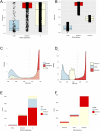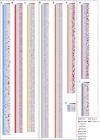Comprehensive evaluation of AlphaMissense predictions by evidence quantification for variants of uncertain significance
- PMID: 39720176
- PMCID: PMC11666499
- DOI: 10.3389/fgene.2024.1487608
Comprehensive evaluation of AlphaMissense predictions by evidence quantification for variants of uncertain significance
Abstract
Accurate variant classification is critical for genetic diagnosis. Variants without clear classification, known as "variants of uncertain significance" (VUS), pose a significant diagnostic challenge. This study examines AlphaMissense performance in variant classification, specifically for VUS. A systematic comparison between AlphaMissense predictions and predictions based on curated evidence according to the ACMG/AMP classification guidelines was conducted for 5845 missense variants in 59 genes associated with representative Mendelian disorders. A framework for quantifying and modeling VUS pathogenicity was used to facilitate comparison. Manual reviewing classified 5845 variants as 4085 VUS, 1576 pathogenic/likely pathogenic, and 184 benign/likely benign. Pathogenicity predictions based on AlphaMissense and ACMG guidelines were concordant for 1887 variants (1352 pathogenic, 132 benign, and 403 VUS/ambiguous). The sensitivity and specificity of AlphaMissense predictions for pathogenicity were 92% and 78%. Moreover, the quantification of VUS evidence and heatmaps weakly correlated with the AlphaMissense score. For VUS without computational evidence, incorporating AlphaMissense changed the VUS quantification for 878 variants, while 56 were reclassified as likely pathogenic. When AlphaMissense replaced existing computational evidence for all VUS, 1709 variants changed quantified criteria while 63 were reclassified as likely pathogenic. Our research suggests that the augmentation of AlphaMissense with empirical evidence may improve performance by incorporating a quantitative framework to aid in VUS classification.
Keywords: ACMG/AMP classification; AlphaMissense; VUS; variant classification; variants of unknown significance.
Copyright © 2024 Kurtovic-Kozaric, Delalic, Mutapcic, Comor, Siciliano and Kiel.
Conflict of interest statement
AK-K, LD, BM, LC, ES, and MK were employed by the company Genomenon.
Figures




Similar articles
-
Classification of BRCA2 Variants of Uncertain Significance (VUS) Using an ACMG/AMP Model Incorporating a Homology-Directed Repair (HDR) Functional Assay.Clin Cancer Res. 2022 Sep 1;28(17):3742-3751. doi: 10.1158/1078-0432.CCR-22-0203. Clin Cancer Res. 2022. PMID: 35736817 Free PMC article.
-
Modeling the ACMG/AMP variant classification guidelines as a Bayesian classification framework.Genet Med. 2018 Sep;20(9):1054-1060. doi: 10.1038/gim.2017.210. Epub 2018 Jan 4. Genet Med. 2018. PMID: 29300386 Free PMC article.
-
ACMG/AMP interpretation of BRCA1 missense variants: Structure-informed scores add evidence strength granularity to the PP3/BP4 computational evidence.Am J Hum Genet. 2025 May 1;112(5):993-1002. doi: 10.1016/j.ajhg.2024.12.011. Epub 2025 Apr 14. Am J Hum Genet. 2025. PMID: 40233743 Free PMC article.
-
The Challenge of VUS in Inherited Retinal Degeneration: Insight from Functional Studies.Adv Exp Med Biol. 2025;1468:51-55. doi: 10.1007/978-3-031-76550-6_9. Adv Exp Med Biol. 2025. PMID: 39930172 Review.
-
Navigating variants of uncertain significance in genetic dyslipidemia: how to assess and counsel patients.Curr Opin Lipidol. 2025 Apr 1;36(2):49-54. doi: 10.1097/MOL.0000000000000971. Epub 2024 Dec 18. Curr Opin Lipidol. 2025. PMID: 39950242 Review.
Cited by
-
Benchmarking AlphaMissense pathogenicity predictions against APP, PSEN1, and PSEN2 variants of unknown significance.Biochem Biophys Rep. 2025 May 16;42:102049. doi: 10.1016/j.bbrep.2025.102049. eCollection 2025 Jun. Biochem Biophys Rep. 2025. PMID: 40486492 Free PMC article.
References
-
- Ahmad R. N. R., Zhang L. T., Morita R., Tani H., Wu Y., Chujo T., et al. (2024). Pathological mutations promote proteolysis of mitochondrial tRNA-specific 2-thiouridylase 1 (MTU1) via mitochondrial caseinolytic peptidase (CLPP). Nucleic Acids Res. 52 (3), 1341–1358. 10.1093/nar/gkad1197 - DOI - PMC - PubMed
-
- Barboso G., Fragnito C., Beghi C., Saccani S., Fesani F. (1987). Asymptomatic patient reoperated on for severe proximal stenosis of circular sequential vein graft. J. Cardiovasc Surg. 28 (3), 341–342. - PubMed
LinkOut - more resources
Full Text Sources

